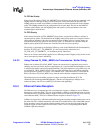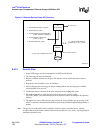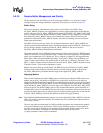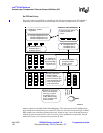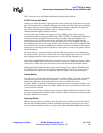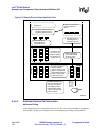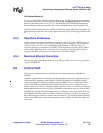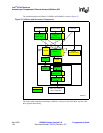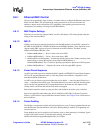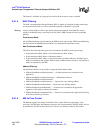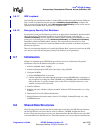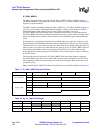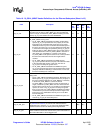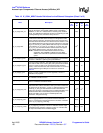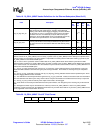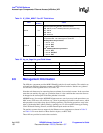
Intel
®
IXP400 Software
Access-Layer Components: Ethernet Access (IxEthAcc) API
Programmer’s Guide IXP400 Software Version 2.0 April 2005
Document Number: 252539, Revision: 007 145
9.6.1 Ethernet MAC Control
The role and responsibility of this module is to enable clients to configure the Ethernet coprocessor
MACs for both NPEs. This API permits the setting and retrieval of uni-cast and multi-cast
addresses, duplex mode configuration, FCS appending, frame padding, promiscuous mode
configuration, and reading or writing from the MII interface.
9.6.1.1 MAC Duplex Settings
Functions are provided for setting the MACs at full or half duplex. This setting should match the
setting of the connected PHYs.
9.6.1.2 MII I/O
IxEthAcc provides four functions that interact with the MII interfaces for the PHYs connected to
the NPEs on the IXDP425 / IXCDP1100 platform and IXDP465 platform. These functions do not
support reading PHY registers of devices connected on the PCI interface. The MAC must be
enabled with IxEthAccMacInit () first.
• IxEthAccMiiReadRtn () — Read a 16 bit value from a PHY
• IxEthAccMiiWriteRtn () — Write a 16 bit value from a PHY
• ixEthAccMiiAccessTimeoutSet() - Override the default timeout value (100ms) and retry count
when reading or writing MII registers using ixEthAccMiiWriteRtn() or
ixEthAccMiiReadRtn(). This is useful for speeding up read/write operations to PHY registers.
• IxEthAccMiiStatsShow () — Displays the values of the first eight PHY registers
9.6.1.3 Frame Check Sequence
An API is provided to provision whether the MAC appends an IEEE-803.2 Frame Check Sequence
(FCS) to the outgoing Ethernet frame or if the data passed to the IxEthAcc component is to be
transmitted without modification.
An API is also provided to provision whether the receive buffer — sent to the Intel XScale core’s
client — contains the frame FCS or not. The default behavior is to remove the FCS from Rx frames
and to calculate and append the FCS on transmitted frames. Rx frames are still subject to FCS
validity checks, and frames that fail the FCS check are dropped.
Both of these interfaces operate on a per-port basis and should be set before a port is enabled.
Special care should be taken when using the VLAN/QoS and 802.3/802.11 Frame Conversion
features, as FCS behavior may be different with these features. See Chapter 10 for clarification on
these conditions.
9.6.1.4 Frame Padding
The IxEthAcc component by default will add up to 60-bytes to any Tx frames submitted that do not
meet the Ethernet required minimum of 64-bytes. When padding is enabled, FCS appending will
also be turned on.
Frame padding may not be desirable in all situations, such as when generating a “heartbeat” signal
to other nodes on the network. To disable frame padding, the function
IxEthAccPortTxFrameAppendPaddingDisable() is available.



